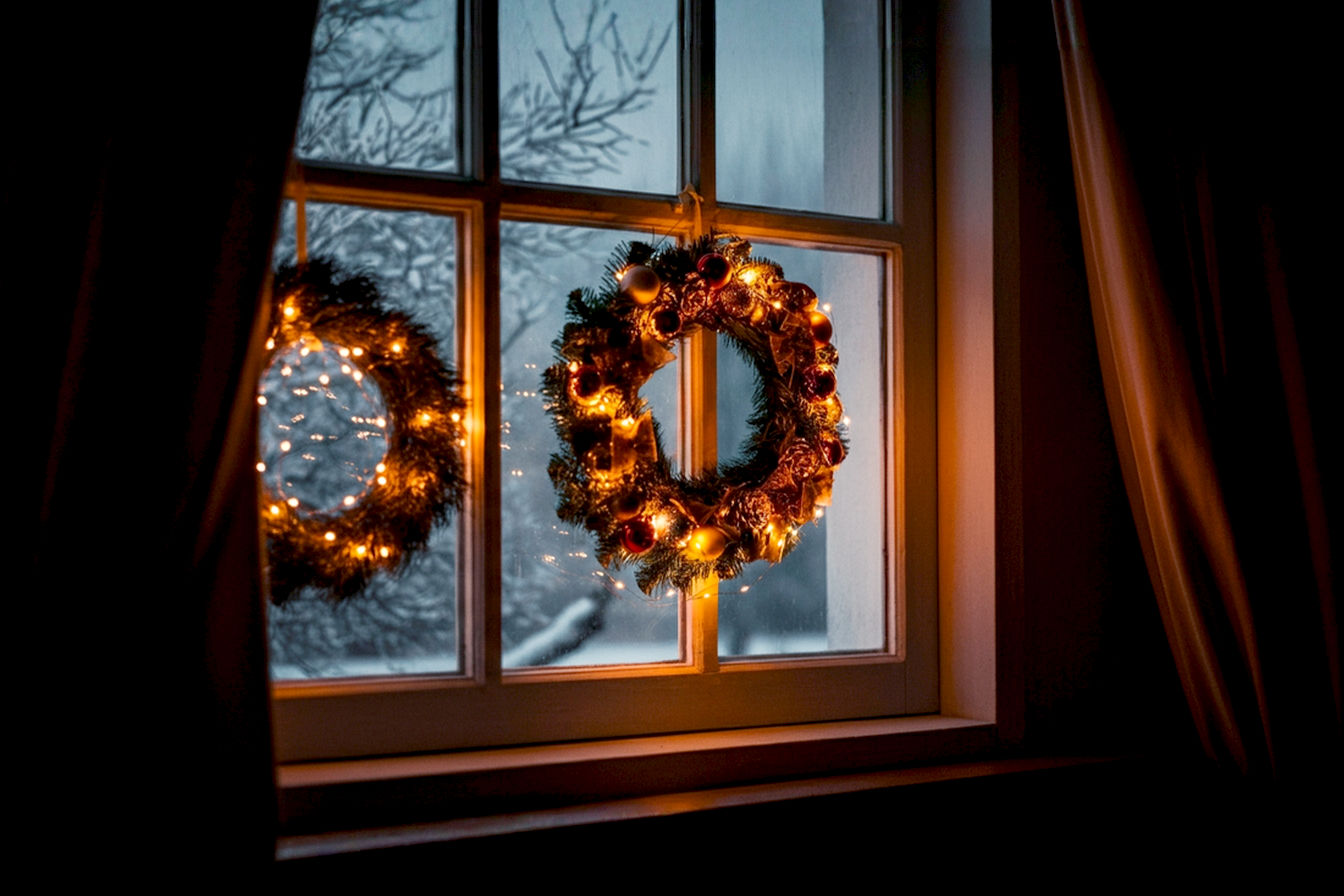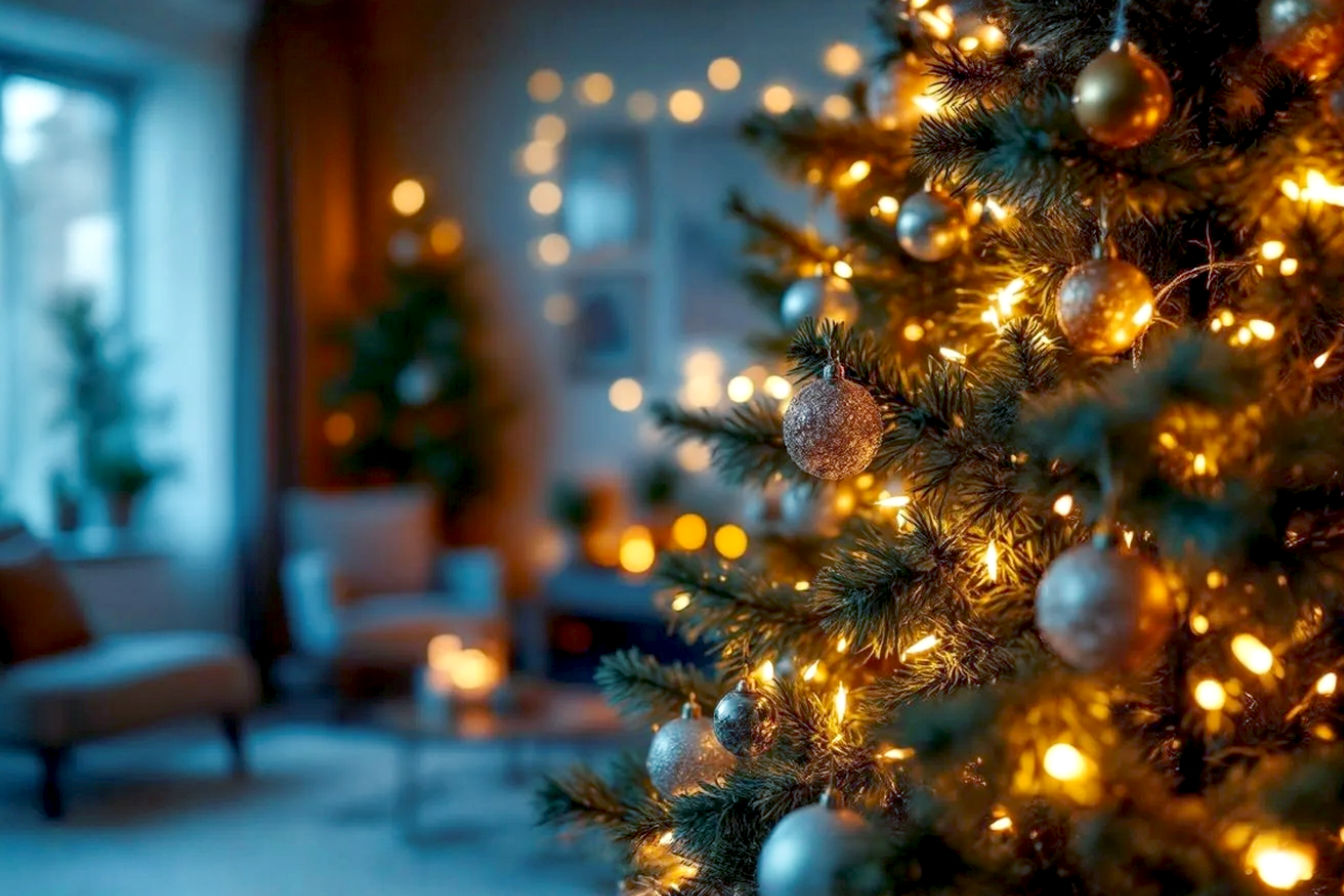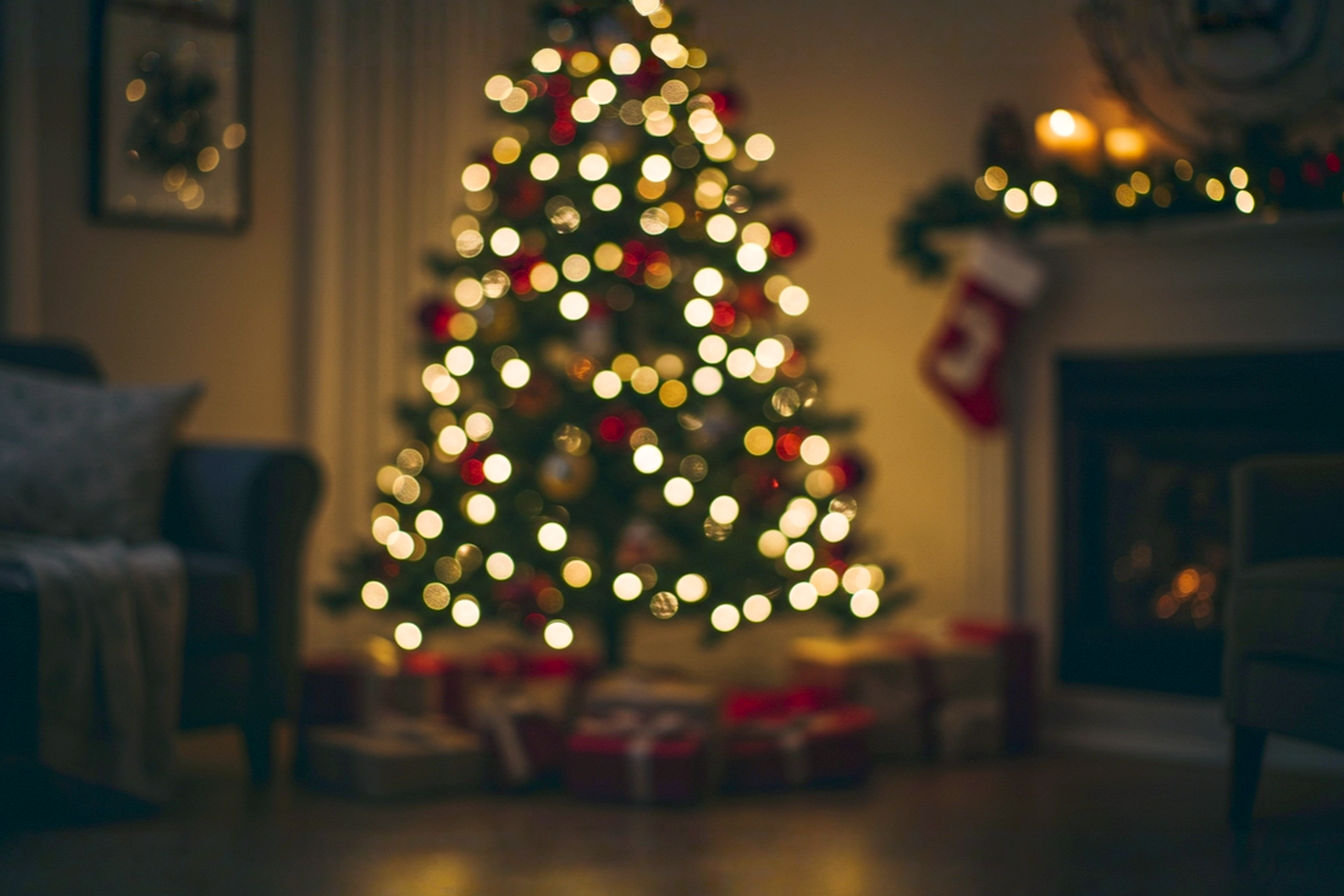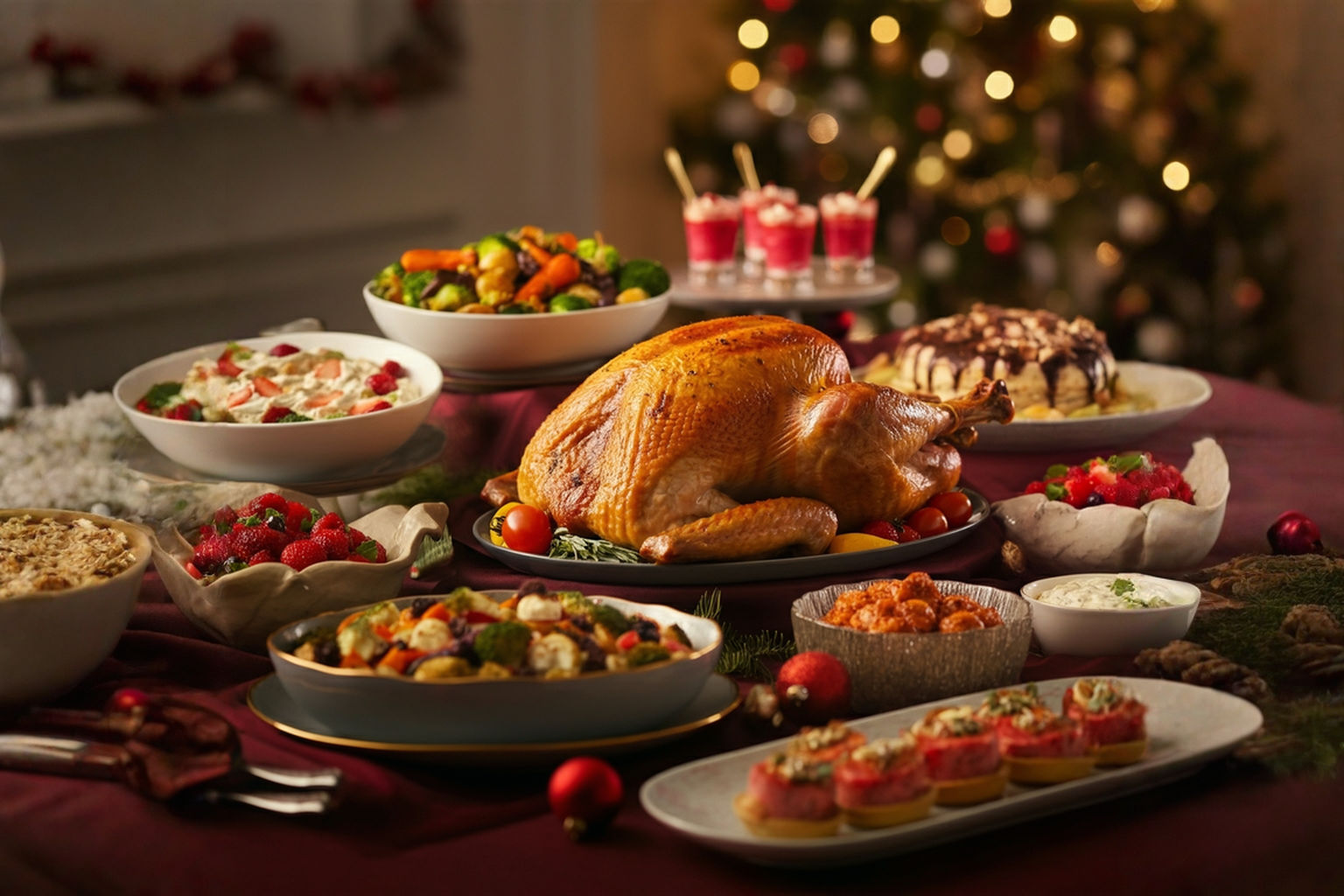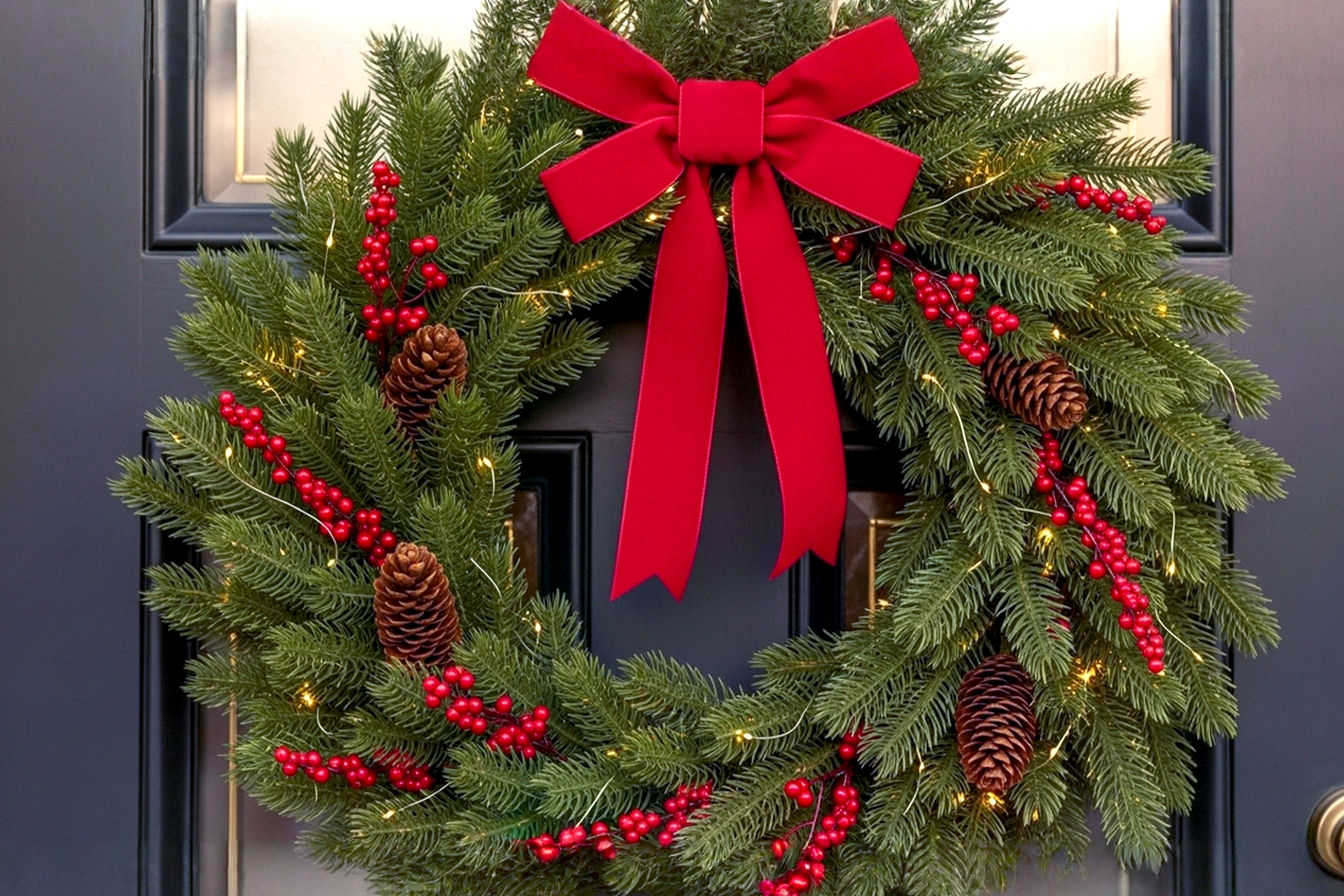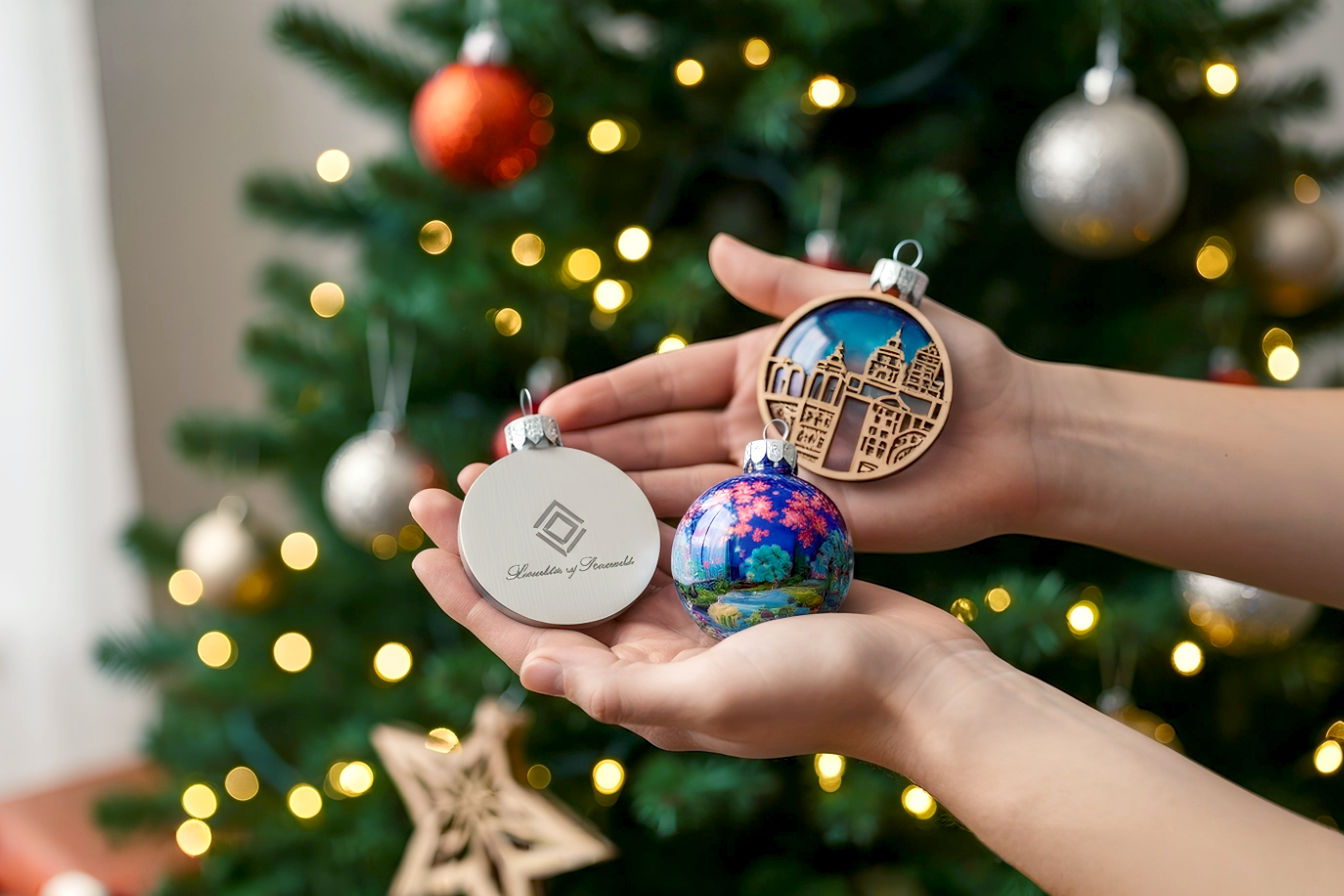This post may contain affiliate links. If you make a purchase through these links, we may earn a commission at no additional cost to you.
The holiday season brings joy, warmth, and, for many, a familiar struggle: the annual battle with tangled Christmas light cords. You know the drill—unearthing a box of lights, only to find a knotted mess of wires, and then the frantic search for available power outlets. It’s a common festive frustration that can dampen the decorating spirit. But what if there was a way to bypass this holiday headache entirely?
Enter battery-operated Christmas tree lights. These innovative lighting solutions offer a liberating alternative to traditional plug-in strands. They promise a hassle-free holiday glow, allowing you to illuminate your home and tree without being tethered to a wall socket. Imagine decorating your tree exactly where you want it, adorning outdoor wreaths without extension cords snaking across the lawn, or adding sparkle to a centerpiece far from any outlet. This article will guide you through everything you need to know about battery-powered Christmas lights, from their undeniable advantages to the key features that make them shine, helping you choose the perfect set for a truly untangled holiday season.
The Unbeatable Advantages of Battery-Operated Christmas Lights
Why should you consider making the switch to battery-powered Christmas lights? The benefits extend far beyond just avoiding tangled cords. They offer a level of flexibility, safety, and aesthetic appeal that traditional lights often can’t match.
Freedom from Outlets: Decorate Anywhere
One of the most compelling reasons to choose battery-operated lights is the sheer freedom they provide from electrical outlets. With conventional lights, your decorating options are limited by the proximity of a power source. This means your Christmas tree might have to sit in a less-than-ideal spot just to reach an outlet, or you might need multiple unsightly extension cords crisscrossing your living room.
Battery lights eliminate this constraint. You can place your Christmas tree in the center of a room, against a window, or even on a porch where no outdoor outlets are readily available. This independence makes them perfect for illuminating wreaths on doors, garlands on staircases, or even small decorative trees in areas where running power would be difficult or impossible. Think about it: no more searching for hidden sockets or struggling with power strips. Just pure, unadulterated decorating freedom.
Enhanced Safety: Reducing Trip Hazards and Electrical Risks
Safety is a paramount concern during the holidays, especially in homes with children or pets. Traditional string lights, with their numerous cords and connections, can introduce several hazards. Long extension cords can become trip hazards, leading to falls, particularly in dimly lit areas. Furthermore, damaged wires or overloaded circuits from too many plugged-in lights can pose electrical risks, including short circuits or even fires.
Battery-operated lights significantly reduce these dangers. Since they don’t require external power cords running across floors, they virtually eliminate trip hazards. Their low voltage operation also means a much lower risk of overheating or electrical shock compared to standard AC-powered lights. This makes them a safer choice for families, offering peace of mind as your loved ones enjoy the festive glow.
Aesthetic Appeal: Seamless, Clutter-Free Decor
Beyond practicality and safety, battery lights offer a distinct aesthetic advantage: a cleaner, more seamless look. With traditional lights, you often see visible power cords snaking down the tree trunk or along branches, detracting from the overall beauty of your carefully arranged decorations. The bulky plugs and connections can also be an eyesore.
Battery-operated lights, especially those designed with discreet battery packs, allow the focus to remain entirely on the brilliant glow of the lights themselves. The small battery boxes can be easily tucked away behind branches, nestled within garlands, or hidden in decorative containers. This creates an uninterrupted flow of light, enhancing the magic of your holiday display without the visual clutter of wires. The result is a more professional and polished appearance that truly lets your decorations shine.
Versatility Beyond the Tree: More Than Just Christmas Decor
While perfect for Christmas trees, the versatility of battery-operated lights extends far beyond just holiday decor. Their portability makes them incredibly useful for a variety of applications throughout your home and garden, year-round.
Consider using them to illuminate:
- Wreaths and Garlands: Easily add sparkle to front door wreaths, stair railings, or mantelpiece garlands without needing an outlet nearby.
- Centerpieces and Table Decor: Create stunning table arrangements for dinner parties or festive gatherings, bringing light to the heart of your dining area.
- Outdoor Shrubs and Planters: Highlight garden features or patio spaces, even if they’re far from an outdoor power source.
- Everyday Decorative Lighting: Use them in glass jars, lanterns, or as accent lighting in bedrooms or living spaces for a cozy ambiance.
Their adaptability means you’re not just buying lights for one season; you’re investing in a versatile decorating tool that can enhance your home’s atmosphere anytime.
Decoding Battery-Operated Christmas Lights: Key Features to Look For
Not all battery-operated Christmas lights are created equal. To ensure you select the best set for your needs, it’s crucial to understand the key features that differentiate them. Paying attention to these details will help you maximize battery life, achieve the desired ambiance, and ensure durability.
Battery Type and Life: Powering Your Holiday Glow
The type of battery a light set uses and its expected lifespan are fundamental considerations. This directly impacts convenience, cost, and how long your lights will shine without needing a battery change.
Common Battery Types: AA, AAA, C, D
Battery-operated Christmas lights typically rely on common household battery sizes, each with its own characteristics:
- AA and AAA Batteries: These are the most common and smallest types. They are widely available and relatively inexpensive. However, their smaller size means they have lower energy capacity (measured in milliampere-hours or mAh). This translates to a shorter runtime, often just a few days to a week of continuous use, depending on the number of LEDs and light mode. They are best suited for smaller light strands or decorations that are only lit for short periods.
- C and D Batteries: These are larger batteries with significantly higher energy capacity. A D battery, for example, can hold several times more charge than an AA battery. This larger capacity means they can power longer light strands or provide illumination for weeks, sometimes even a month, on a single set of batteries. While the batteries themselves are more expensive and the battery packs larger, the extended runtime can be a major convenience, especially for outdoor displays or larger trees.
Understanding the mAh rating is key. A higher mAh rating indicates a greater charge capacity, meaning the battery can deliver power for a longer duration. For instance, a standard AA alkaline battery might have a capacity of around 2,000-2,700 mAh, while a D battery can range from 12,000-20,000 mAh. This difference in capacity directly correlates to the potential runtime of your lights.
The Role of LEDs: Energy Efficiency for Longer Life
Virtually all modern battery-operated Christmas lights use Light Emitting Diodes (LEDs). This isn’t just a trend; it’s a critical technological advancement that directly impacts battery life.
LEDs are incredibly energy-efficient compared to traditional incandescent bulbs. Incandescent bulbs produce light by heating a filament, which wastes a significant amount of energy as heat. LEDs, on the other hand, produce light through the movement of electrons in a semiconductor material, generating very little heat. This means they convert a much higher percentage of the electrical energy they consume into light.
For battery-powered lights, this efficiency is paramount. Because LEDs draw significantly less power, they can operate for much longer on the same set of batteries. A string of 50 LED lights might consume only a fraction of the power of 50 incandescent bulbs, extending battery life from hours to days or even weeks. This reduced power consumption is the primary reason why battery-operated Christmas lights are a viable and practical option today.
Rechargeable Batteries: A Sustainable Choice
While disposable alkaline batteries are convenient for initial setup, rechargeable batteries (like NiMH or Li-ion) offer a more sustainable and cost-effective solution in the long run.
The initial investment in rechargeable batteries and a charger is higher than buying a pack of disposables. However, over multiple holiday seasons, the savings can be substantial. Instead of constantly buying new batteries, you simply recharge your existing ones. This not only saves money but also reduces waste, making them an environmentally friendly choice.
When using rechargeable batteries, it’s important to choose ones with a high mAh rating to maximize runtime. Also, be aware that rechargeable batteries generally have a slightly lower nominal voltage (e.g., 1.2V for NiMH compared to 1.5V for alkaline) which can sometimes result in slightly dimmer lights towards the end of their charge cycle, though this is often imperceptible. For optimal performance, ensure your charger is designed for the specific battery chemistry (NiMH, Li-ion) you are using.
Light Type and Brightness: Setting the Perfect Ambiance
The visual appeal of your Christmas lights depends heavily on the type of light they emit and their overall brightness. These factors contribute significantly to the ambiance you create.
Warm White vs. Cool White vs. Multicolor
The color temperature of your lights plays a huge role in the mood of your display:
- Warm White: These lights emit a soft, yellowish glow, similar to traditional incandescent bulbs or candlelight. They create a cozy, nostalgic, and inviting atmosphere, perfect for a classic Christmas feel. The color temperature is typically around 2700K-3000K (Kelvin).
- Cool White: These lights have a brighter, more bluish-white hue, often described as crisp or modern. They can create a more contemporary, icy, or stark look, which might be preferred for certain themes or to highlight specific decorations. Their color temperature is usually above 5000K.
- Multicolor: These strands feature a mix of colors, often red, green, blue, and yellow. They evoke a playful, vibrant, and traditional Christmas spirit. Some advanced sets offer RGB (Red, Green, Blue) LEDs, which can be programmed to display a vast spectrum of colors, allowing for dynamic color changes and custom themes via remote or app control. This provides immense flexibility to match your mood or decor scheme throughout the season.
Brightness Levels: Lumens and Light Density
Understanding brightness is crucial for achieving your desired festive impact:
- Lumens: While not always explicitly stated on Christmas light packaging, lumens are the standard unit of measurement for the total amount of visible light emitted by a source. A higher lumen count means a brighter light. For battery lights, individual LEDs typically produce a relatively low number of lumens (e.g., 0.5 to 2 lumens per LED). However, the cumulative effect of many LEDs creates the overall brightness.
- Light Density: This refers to the number of individual lights per unit of length (e.g., lights per foot or meter). A strand with 100 lights over 10 feet will have a higher light density than 100 lights over 20 feet. Higher light density generally translates to a brighter, more saturated glow, even if individual LEDs aren’t extremely bright. For a truly dazzling, dense look, you’ll want lights with a higher count per foot. Conversely, a sparser look might require fewer lights per foot. Consider the size of your tree and the desired effect when evaluating light density.
Functionality and Control: Smart Features for Effortless Operation
Modern battery-operated lights often come with features that enhance convenience and allow for greater customization. These smart functions can transform your decorating experience from a chore into a joy.
Integrated Timers: Set It and Forget It
One of the most popular and practical features is an integrated timer function. Many battery light sets come with a built-in timer that allows you to set the lights to turn on for a specific duration and then automatically turn off. The most common setting is “6 hours on, 18 hours off.”
Here’s how it works: You turn the lights on at your desired time (e.g., 5 PM). The timer activates, keeping the lights on for six hours (until 11 PM). They then automatically switch off for 18 hours, turning back on again at 5 PM the next day. This cycle repeats daily.
The benefits are clear:
- Convenience: No need to remember to turn lights on or off every day.
- Battery Saving: Prevents lights from running continuously, significantly extending battery life. This is especially important for battery-powered units, as continuous operation would drain batteries very quickly.
- Consistency: Your display will illuminate and extinguish at the same time daily, creating a reliable festive schedule.
Remote Control: Convenience at Your Fingertips
Many battery light sets include a small remote control, offering greater flexibility without needing to access the battery pack directly.
- IR (Infrared) vs. RF (Radio Frequency) Remotes:
- IR Remotes: These require a direct line of sight between the remote and the receiver on the battery pack. They are similar to TV remotes. Their range is typically limited to 10-15 feet. If the battery pack is hidden deep within a tree, an IR remote might not work reliably.
- RF Remotes: These use radio waves and do not require a direct line of sight. They can operate through walls or around obstacles, offering a much greater range (often 30-50 feet or more). RF remotes are generally more convenient for Christmas tree lights, as the battery pack is often concealed.
Remote controls typically allow you to:
- Turn lights on/off.
- Select different lighting modes (e.g., steady on, slow fade, twinkle, chasing, waves).
- Adjust brightness levels (dimming).
- Activate or deactivate the timer function.
Smart App Control: The Future of Holiday Lighting
For the ultimate in convenience and customization, some higher-end battery-operated lights offer smart app control via Bluetooth or Wi-Fi connectivity.
- Bluetooth Connectivity: Lights connect directly to your smartphone or tablet via Bluetooth. This offers a good range (typically up to 30-50 feet without major obstructions) and allows for quick setup.
- Wi-Fi Connectivity: Lights connect to your home Wi-Fi network, allowing control from anywhere with an internet connection. This is ideal for integrating with existing smart home systems (like Google Home or Amazon Alexa).
Smart app control unlocks advanced features:
- Advanced Customization: Create custom color patterns, animations, and sequences.
- Granular Scheduling: Set detailed schedules for when lights turn on/off, down to the minute, and vary by day of the week.
- Music Synchronization: Some apps allow lights to sync with music, creating a dynamic light show.
- Integration with Smart Home Systems: Control your Christmas lights with voice commands or integrate them into broader smart home routines.
While these features often come at a higher price point, they offer unparalleled control and a truly modern holiday lighting experience.
Durability and Weather Resistance: For Indoor and Outdoor Use
If you plan to use your battery lights outdoors, or even if they’ll be near a window where condensation might occur, their durability and weather resistance are critical.
IP Ratings Explained: Understanding Ingress Protection
The international standard for defining levels of sealing effectiveness of electrical enclosures against intrusion from foreign bodies (dust, dirt, etc.) and moisture is the IP (Ingress Protection) rating. This two-digit code provides vital information:
- The first digit indicates protection against solid objects (dust, fingers, tools).
- The second digit indicates protection against liquids (water).
For Christmas lights, focus on the second digit for water resistance:
- IPX4 or IP44: The “X” in IPX4 means no specific rating for solid objects (or it’s not tested). IP44 means protection against solids larger than 1mm (like wires) and protection against splashing water from any direction. This rating is generally sufficient for outdoor use in sheltered areas (e.g., under an eaves, on a covered porch) or for light rain. It’s not designed for heavy downpours or submersion.
- IP65: This is a much higher rating. The “6” means it’s dust-tight (no ingress of dust). The “5” means protection against low-pressure water jets from any direction. Lights with an IP65 rating are suitable for more exposed outdoor environments, capable of withstanding moderate rain and snow. They are not designed for submersion but offer robust protection against typical weather conditions.
- IP67/IP68: These ratings indicate protection against temporary (IP67) or continuous (IP68) submersion in water. While overkill for most Christmas tree lights, you might find this on specialized outdoor landscape lighting.
When choosing lights for outdoor use, always check the IP rating. An IP44 or IP65 rating is generally recommended for reliable outdoor performance.
Material Quality: Longevity in Harsh Conditions
Beyond the IP rating, the overall material quality contributes to the longevity of your battery lights, especially in outdoor or high-traffic environments.
- Wire Gauge: Thicker wires (lower gauge numbers) are generally more durable and less prone to breakage, especially in cold weather where plastic can become brittle.
- Bulb Housing: Look for robust, sealed bulb housings that protect the LED components from moisture and impact.
- Battery Casing: The battery box itself should be made of durable, weather-resistant plastic with a secure, tight-fitting seal to prevent water ingress.
- UV Resistance: For lights exposed to direct sunlight, UV-resistant materials will prevent the plastic from becoming brittle and discolored over time.
Investing in lights with good material quality ensures they will withstand the elements and last for many holiday seasons.
Choosing the Best Battery Christmas Lights for Your Tree
With a better understanding of the features, you’re ready to select the perfect battery-operated lights for your specific needs. Several factors should influence your decision, from the size of your tree to your personal style.
Tree Size and Light Quantity: How Much Glow Do You Need?
The size of your Christmas tree is the primary determinant of how many lights you’ll need to achieve your desired effect. A common guideline is to use 100 lights per foot (or 30 cm) of tree height for a standard, well-lit look. For a more dazzling, dense, or “designer” look, you might aim for 150-200 lights per foot.
Here’s a quick guide:
- 4-foot (1.2m) tree: 400 lights (standard) to 600 lights (dense)
- 6-foot (1.8m) tree: 600 lights (standard) to 900 lights (dense)
- 7.5-foot (2.3m) tree: 750 lights (standard) to 1125 lights (dense)
- 9-foot (2.7m) tree: 900 lights (standard) to 1350 lights (dense)
Since battery-operated strands are often shorter (e.g., 20-50 lights per strand), you’ll likely need multiple sets to adequately light your tree. Plan accordingly to ensure you have enough battery packs to distribute evenly and hide discreetly.
Indoor vs. Outdoor Considerations: Specific Requirements
As discussed with IP ratings, the intended location of your lights significantly impacts the type you should choose.
- Outdoor Use: Always prioritize lights with an IP44 or, ideally, an IP65 rating. This ensures they can withstand rain, snow, and moisture. Also, consider how battery performance is affected by cold temperatures. Extreme cold can temporarily reduce battery capacity and output. Some battery packs are designed with better insulation for cold weather.
- Indoor Use: For indoor trees and decorations, IP ratings are less critical, but general durability is still a plus. The primary concerns will be battery life, light type, and control features.
Aesthetic Preferences: Matching Your Decor Style
Christmas lights come in a vast array of styles, allowing you to match your personal aesthetic and existing decor.
- Traditional vs. Modern:
- Traditional: Warm white mini lights or classic C7/C9 style bulbs (even in LED form) evoke a nostalgic, classic Christmas.
- Modern: Cool white lights, color-changing RGB lights, or minimalist fairy lights often suit contemporary decor.
- Light Style:
- Fairy Lights: These are tiny, delicate LEDs on thin, flexible wire (often copper or silver). They are incredibly versatile for weaving into garlands, filling jars, or creating a subtle, magical twinkle.
- Globe Lights: Small, spherical bulbs that offer a softer, diffused glow.
- Mini Lights: The classic small bulb shape, now almost exclusively LED.
- C7/C9 Style: Larger, more traditional bulb shapes that make a bolder statement.
- Wire Color: The color of the wire itself can impact the seamlessness of your display.
- Green Wire: Best for blending into artificial or real Christmas tree branches.
- Clear/Silver Wire: Ideal for white trees, glass containers, or when the wire needs to be as invisible as possible.
- Brown Wire: Useful for blending into natural wood or darker outdoor elements.
Budget and Value: Balancing Cost and Quality
Like any purchase, budget plays a role. Battery-operated lights range in price based on features, length, and quality.
- Initial Price vs. Long-Term Battery Costs: While a cheaper set might seem appealing upfront, consider the ongoing cost of batteries. A more expensive set with better energy efficiency (due to superior LEDs or circuitry) or one that uses larger, longer-lasting batteries might be more economical in the long run, especially if you plan to use them frequently.
- Warranty and Brand Reputation: Reputable brands often offer better quality control and warranties, providing peace of mind. Reading reviews can also give you insight into the real-world performance and durability of different sets. Balancing the upfront cost with expected lifespan and recurring battery expenses will help you determine the true value.
Installation and Maintenance Tips for Optimal Performance
Once you’ve chosen your battery-operated Christmas lights, proper installation and maintenance will ensure they look their best and last for many holiday seasons.
Strategic Placement: Hiding Battery Packs and Maximizing Impact
The key to a truly seamless look with battery lights is to effectively conceal the battery packs while ensuring the lights themselves are prominently displayed.
- For Christmas Trees:
- Deep within Branches: Tuck battery packs deep into the dense foliage of the tree, near the trunk. The branches will naturally obscure them.
- At the Base: For smaller trees or tabletop decorations, you can often hide the battery pack at the very base of the tree, perhaps behind a tree skirt or a decorative pot.
- Use Ties: Small zip ties, floral wire, or even green twist ties can help secure the battery pack to a branch, preventing it from dangling or becoming visible.
- For Wreaths and Garlands:
- Behind the Decoration: Position the battery pack on the back side of the wreath or garland, against the wall or door, where it won’t be seen.
- In a Pouch: For outdoor wreaths, a small, waterproof pouch can hold the battery pack, protecting it while keeping it discreet.
- For Centerpieces/Vases:
- Underneath or Inside: For glass vases or decorative bowls, you can often place the battery pack at the bottom, covered by decorative filler like faux snow, ornaments, or even larger branches.
The goal is to make the lights appear as if they’re magically glowing from within, without any visible power source.
Battery Best Practices: Extending Life and Ensuring Safety
Proper battery care is essential for maximizing the runtime of your lights and ensuring safe operation.
- Use Fresh, Quality Batteries: Always start the season with fresh, high-quality alkaline batteries. Cheaper, generic brands may have lower capacities and shorter lifespans.
- Remove Batteries During Storage: This is a crucial step. Batteries can leak over time, especially in fluctuating temperatures, causing corrosion and permanent damage to the battery pack and light circuitry. Always remove all batteries before packing your lights away for the season.
- Avoid Mixing Old and New Batteries: Mixing old and new batteries, or different brands/types of batteries, can lead to uneven discharge. The stronger batteries will try to “charge” the weaker ones, leading to overheating, leakage, and reduced overall performance. Always use a fresh set of the same type and brand.
- Using Rechargeable Batteries Effectively:
- Full Charge: Ensure rechargeable batteries are fully charged before each use, especially at the start of the holiday season.
- Cycle Life: Rechargeable batteries have a finite number of charge cycles. While they are sustainable, their capacity will gradually decrease over hundreds of cycles.
- Temperature: Rechargeable batteries can be more sensitive to extreme cold than alkaline batteries, potentially showing reduced performance in very low temperatures. Store them at room temperature.
Troubleshooting Common Issues: Quick Fixes for a Flawless Display
Even with the best lights, minor issues can arise. Here are some quick troubleshooting tips:
- Lights Not Turning On:
- Check Batteries: The most common culprit. Are they inserted correctly (polarity)? Are they dead? Try a fresh set.
- Check Connections: Ensure the battery pack is securely closed and any connectors between light strands are firmly seated.
- Timer Setting: If the lights have a timer, ensure it’s not set to “off” or that you haven’t accidentally activated it at an inconvenient time. Try resetting the timer or turning it off completely to test.
- Remote Battery: If using a remote, check its battery.
- Dimming Lights:
- Low Batteries: This is a clear sign that the batteries are running low. Replace them immediately. LEDs will often dim significantly before completely failing when battery voltage drops.
- Remote Not Working:
- Remote Battery: Replace the battery in the remote control.
- Line of Sight (IR Remotes): Ensure there’s no obstruction between the remote and the battery pack’s sensor if it’s an IR remote.
- Distance: You might be too far away from the receiver.
- Flickering Lights:
- Loose Connection: Check the battery pack connection or any points where strands connect.
- Failing Batteries: Batteries that are almost dead can cause inconsistent power delivery, leading to flickering.
- Defective Strand: Rarely, a single strand might be defective.
Storage Solutions: Keeping Your Lights Ready for Next Year
Proper storage is crucial for extending the life of your battery-operated Christmas lights and making next year’s decorating a breeze.
- Coil Neatly: Avoid simply stuffing lights into a box. Neatly coil each strand around your hand, a piece of cardboard, or a dedicated light reel. This prevents tangling and reduces stress on the wires.
- Original Packaging or Dedicated Storage: If you have the original boxes, they are often designed to protect the lights. Otherwise, consider dedicated Christmas light storage containers or clear plastic bins that protect them from dust and damage.
- Protect from Extreme Temperatures: Store lights in a cool, dry place, away from extreme heat or cold. Attics and uninsulated garages can experience wide temperature fluctuations that can degrade plastic components and wire insulation over time. A climate-controlled closet or basement is ideal.
- Labeling: Label each box or coil with the type of lights (e.g., “Warm White Fairy Lights, 50 LEDs, AA Battery”) to make next year’s setup even easier.
Top Picks: Recommended Battery-Operated Christmas Lights
While I can’t recommend specific brands or products, here’s a general guide to what makes a “top pick” in different categories of battery-operated Christmas lights. Look for these characteristics when making your purchase.
Best Overall: A Well-Rounded Option
Look for a set that strikes an excellent balance between features, performance, and value. This would typically include:
- Efficient LED Technology: For long battery life.
- Common Battery Type: Such as AA or C, offering a good balance of availability and capacity.
- Integrated Timer: A reliable 6-hour on/18-hour off timer.
- Multiple Lighting Modes: Steady on, twinkle, fade, etc.
- Good Length and Light Count: Sufficient for a medium-sized tree or significant decorative coverage.
- Durable Construction: Quality wire and battery casing.
Best for Outdoor Use: Highly Durable, Weather-Resistant
For outdoor applications, prioritize robust protection against the elements:
- High IP Rating: Ideally IP65, ensuring strong resistance to rain and dust.
- Durable Materials: Thick wire gauge, sealed bulb housings, and a robust, tightly sealed battery box.
- Cold Weather Performance: Batteries and components that can withstand lower temperatures without significant performance degradation.
- Longer Runtime: Often uses C or D batteries for extended illumination outdoors.
Best for Smart Features: App-Controlled or Advanced Remote
If cutting-edge control is your priority, seek out lights with advanced connectivity:
- Bluetooth or Wi-Fi Connectivity: For seamless control via a smartphone app.
- Extensive App Features: Custom color palettes, dynamic effects, precise scheduling, and potentially music sync.
- RF Remote: If an app isn’t available, an RF remote is superior to IR for hidden battery packs.
- Brightness Control: Dimmable options for setting the perfect mood.
Best Value: Cost-Effective, Reliable Option
For those on a budget who still want reliable performance:
- Affordable Price Point: Without sacrificing essential functionality.
- Decent Battery Life: Achieved through efficient LEDs and potentially AA or AAA batteries for smaller strands.
- Basic Timer Function: A simple 6-hour timer is often included even on budget-friendly sets.
- Good User Reviews: Indicating reliability and customer satisfaction despite the lower cost.
Best Fairy Lights: Delicate, Versatile Option
For a subtle, magical glow and extreme flexibility:
- Thin, Flexible Wire: Often copper or silver, making them easy to shape and hide.
- Tiny, Bright LEDs: Creating a delicate, ethereal sparkle.
- Compact Battery Pack: Easily concealable in small spaces.
- Versatile Use: Ideal for wrapping around small objects, filling jars, or accenting delicate decorations.
- Good Length Options: Available in various lengths to suit different projects.
Conclusion
The days of wrestling with tangled cords, searching for elusive outlets, and worrying about electrical hazards can be a thing of the past. Battery-operated Christmas tree lights offer a truly liberating solution, transforming your holiday decorating into a hassle-free, joyful experience.
By understanding the advantages of cordless illumination—from unparalleled placement flexibility and enhanced safety to a cleaner, more aesthetically pleasing display—you can see why these lights are gaining immense popularity. When choosing your set, consider the critical features like battery type and life, the desired light color and brightness, and the convenience of integrated timers, remote controls, or smart app connectivity. And for outdoor displays, always prioritize high IP ratings and durable construction.
With the right battery-operated lights, you’re not just decorating; you’re creating a magical, untangled holiday glow that truly shines. Embrace the freedom, enhance the safety, and enjoy the effortless beauty that battery-powered Christmas lights bring to your festive home. Get ready to illuminate your holidays with ease and brilliance!

